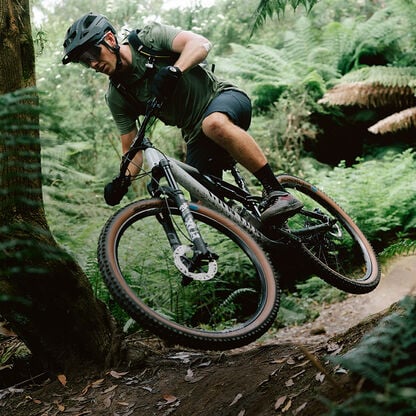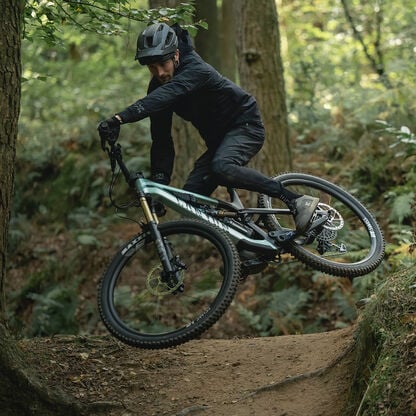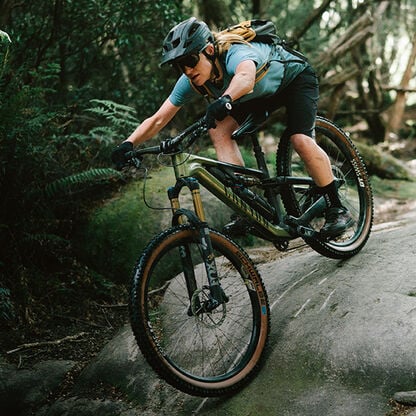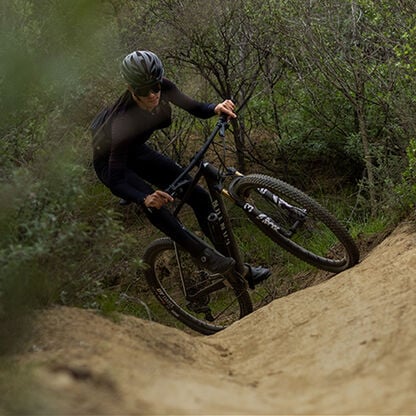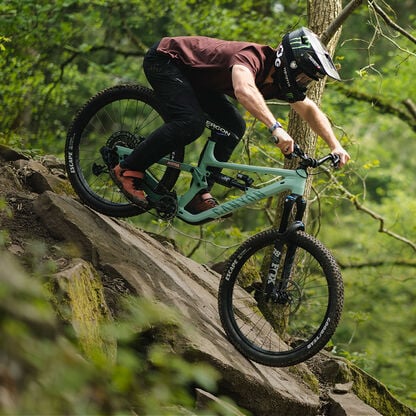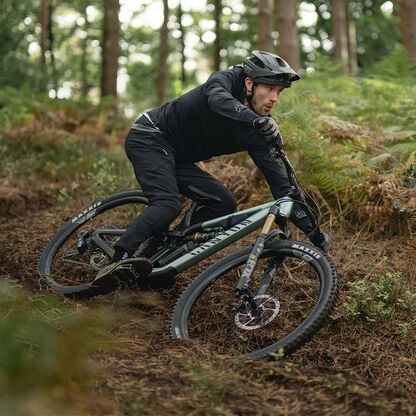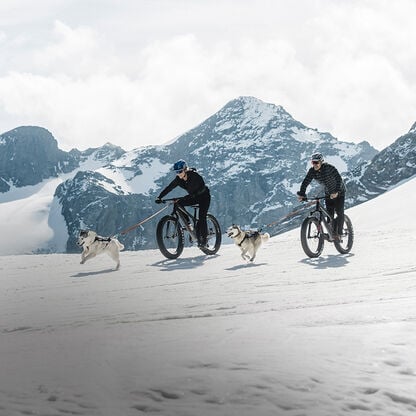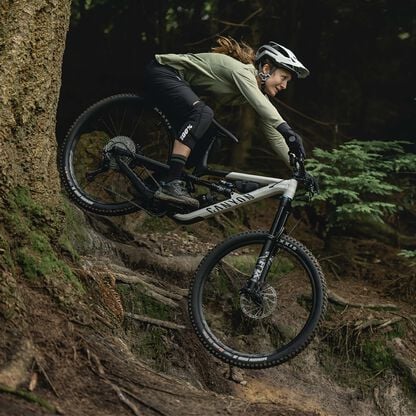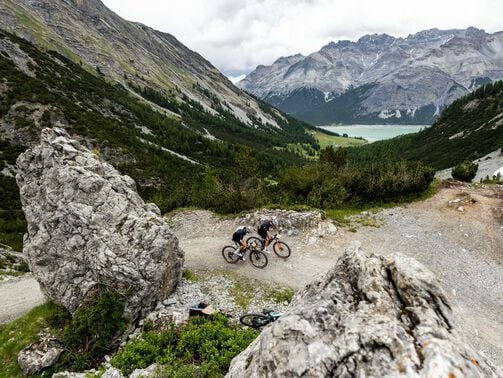How to set up suspension on your mountain bike: Essential guide
Setting up MTB suspension doesn’t have to be a dark art. In this guide, we explain the basics with video demos to show how to adjust yours for the optimum ride.


Nothing will ruin your flow on the trails more than incorrect mountain bike suspension set up. Riding a bike that feels sluggish, unsupportive or nervous in all the wrong places is not the best recipe for type 1 fun.
Getting suspension set up right is a balancing act of compromise and sacrifice, but a good place to start is the manufacturer's guidance which you’ll find on your Fox or Rockshox suspension or online. This is a base level to build from as you test and tweak the perfect set up.
Read on and watch the video below to learn how to adjust mountain bike suspension.
Contents
Suspension on mountain bikes: Understanding the basics
Before we get into how to adjust mountain bike suspension, let’s first look at how it actually works, and explain the key terms.
Suspension is essentially the shock absorption or spring rate of the bike and how fast it compresses and returns under pressure. The ‘spring’ can be either mechanical with a coil, or air sprung, with pressurised air in a chamber, which is more common.
In full suspension mountain bikes, the front forks are responsible for front wheel movement of travel, and the rear shock controls the back wheel movement.
For a detailed guide on the differences between coil vs air shocks and which is best, read our other blog.
Travel: How much suspension travel do I need?
‘Travel’ in MTB suspension refers to the amount of vertical (or near enough vertical) movement of the wheel as the suspension compresses over mixed terrain – basically how much the mountain bike moves up and down as you’re riding forwards on the trail.
It’s measured in mm and different mountain bikes (Cross-country (XC), trail, enduro, downhill), will have different amounts of travel in their suspension for optimum control and comfort over varying terrain.
Full suspension XC and lightweight trail bikes like the Neuron will typically have 100-140mm front and up to 130mm rear suspension to be more efficient at pedalling, stronger on the climbs, and generally more agile, playful and poppy.
Enduro or downhill bikes will have more travel in front and rear suspension (160-200mm) to soak up bigger hits and feel more planted over rough trails, with enough squish to comfortably land bigger drops and jumps.
Bigger travel trail bikes like the Spectral sit in between the two, with 150mm front and 140mm rear suspension, for greater versatility.

Adjustable components of MTB suspension: Sag, rebound, and compression
When it comes to fine-tuning your MTB suspension, sag, rebound, and compression are the three critical adjustments. Each of these components influences the overall performance and comfort of your ride.
Mountain bike sag: Setting the right suspension balance
Sag refers to how soft or hard your suspension is, and the amount of travel that’s used to support your full bodyweight on the bike. It’s adjusted according to rider weight by adding or removing air with a shock pump if you have an air shock, or by setting the spring rate and preload for a coil shock.
Depending on your bike, riding style, preference and trail terrain, the ideal sag is 20-35% of full suspension travel – with trail bikes at the lower end of 20-25%, and enduro / downhill at the higher end. These base measurements are a starting point for you to test and fine tune further.
It’s important to get the sag right for your weight (wearing full kit) to make sure your ride is efficient, comfortable and most importantly, fun!
Understanding rebound damping
Rebound refers to how fast the suspension returns to full travel after hitting a bump (compressing) in the trail. Damping refers to the amount of resistance applied to that rebound.
Rebound damping is adjusted with dials on the underside of the fork or rear MTB suspension by turning towards or away from a tortoise and hare, ‘+’ and ’-’, or ‘fast’ and ‘slow’ sign.
Setting your rebound just right is a careful balancing act between the right amount of low speed and high speed rebound damping. Low speed applies to general trail undulations and the bike bobbing up and down when pedalling (pedal bob); and high speed applies to bigger hits and when the suspension needs to retract quickly between features.
Too little rebound damping will retract the suspension out of compression too fast and make the bike feel nervous and harsh, reducing traction in the trail with little control. If rebound damping is too high, the suspension will sink or ‘pack down’ too far into the travel and not rebound fast enough between impacts in the trail, feeling sluggish when pedalling.
Most mountain bikes only have a single rebound adjuster, usually low speed, though some higher end models like the Torque 29 CF 8 have a high speed rebound adjuster too for more precise tuning.
Top tip: If you’re riding high-speed terrain like bike parks or technical mountain descents, test and find a faster rebound setting that works for you to reduce arm pump.
Optimizing compression damping for your MTB
Compression is the exact opposite to rebound and is the rate of the suspension’s compression during impact – not the rate of its return.
Similar to rebound damping, compression damping is also separated into low speed and high speed. Low speed compression applies for slower compressions, i.e. riding over general bumps, undulations or corners in the trail, pedal bob, etc. High speed compression applies for more demanding features such as square-edged bumps, big jumps and drops that requires the suspension to compress quickly with fully supported landings.
Not all bikes have separate high speed and low speed adjustable compression damping, but some do, like our race-winning Strive, fitted with FOX 38 Factory mountain bike forks. Both high and low speed compression settings are adjustable via blue dials on the fork, with several other tuning options to perfect your setup.
The balance to be had with both rebound and compression damping is that you want the bike to feel plush and supported through technical terrain, responding and recovering quickly to bumps in the trail without wallowing or ‘sinking’ all the time.
So while the recommended measurements from suspension manufacturers are a great base, it’s definitely worth spending some time tweaking and testing different settings on trails you’re familiar with to really dial in to what works for you.
Setting up MTB suspension: Quick video steps
The video below features a quick MTB suspension set up for the Neuron but these steps can universally apply to adjusting front and rear suspension on most mountain bikes with air shocks.
Step-by-step guide: How to set sag on front and rear mountain bike suspension
- Look on the fork and shock body or manufacturer’s website for the air pressure and rebound measurements according to rider weight.
- Undo the air valve on the left fork stanchion and attach the suspension pump. Add air to the specified pressure and replace the valve cap.
- On the rear shock body, undo the correct valve cap (on the Neuron, it’s black), and attach the suspension pump. Add air to the specified pressure according to rider weight and do the cap back up.
- Position the rubber o-rings at the top of the rear shock body (towards the handlebars), and the bottom of the front fork stanchion (towards the wheel). The o-rings are helpful indicators to show the amount of sag once you sit on the bike.
- Carefully step onto the bike and stand over in ready position, and push down with full weight over the bike a few times, then return to normal standing or seated position. If you’re doing this alone, position the bike next to a wall, or if you have a friend to help they can hold the front wheel to make sure you stay balanced. You might want to also drop the saddle to make it easier to get on and off.
- Carefully step off the bike making sure not to bounce, and check the position of the o-rings. For the Neuron, or most bikes, the optimum sag on the rear shock is 20-25%, or around a quarter. For an enduro bike, the optimum is 30-35%, or around a third. For the forks, it’s around 15-20%.
- If the o-rings on the fork and rear shock have moved less than the required amount, remove air and re-test. If they’ve moved more, use the shock pump to add air and re-test.

Rear suspension on mountain bikes: adjusting coil vs air shocks
Most full suspension mountain bikes come fitted with air shocks at the rear for easier tunability out of the box, but coil shocks are becoming more popular for harder-hitting enduro and downhill bikes.
Both coil and air shocks do the same job but there are key differences in tunability, ride feel and maintenance requirements.
Air shocks have the advantage of being infinitely tunable with a shock pump to add or remove air, whereas tuning a coil shock is a one-time job and you have to set the correct spring rate for rider weight. Changing the spring rate often means replacing the spring, unless you can make a big enough difference by adjusting the preload.
Preload - to adjust coil shocks
For coil suspension only, preload is an adjustment that changes the amount of force needed to compress the coil spring. It works by turning a dial on the shock body to pre-load the spring, raising the height of the bike and reducing sag.
Most manufacturers only allow up to five turns so this is a limited option if the spring is not right for your weight.
Volume spacers - to adjust air shocks
Specifically for air sprung suspension if you need further fine tuning, these cylindrical pieces of plastic are fitted inside the shock body and fork stanchions to adjust the amount of pressurised air inside and increase the suspension’s progression rate.
They’re particularly useful to make your suspension firmer if you find yourself bottoming out a lot even with your sag set correctly set to your weight.
Fine-tuning your MTB suspension: A personalized approach
While the base guides are useful, dialling in your perfect MTB suspension is very much a ‘test and learn’ exercise based on personal preference, riding style and terrain.
Understanding how mountain bike suspension works and how sag, rebound and compression settings affect how it rides will help to master the dark art of suspension tuning, whichever bike you’re on.
Discover our Mountain Bikes
Did this article help?
Thank you for your feedback
-
 About the author
About the authorTess Agnew
Tess is a freelance copywriter, social media and communications pro based in Brighton with a passion for the outdoors and the mental health benefits it brings.
